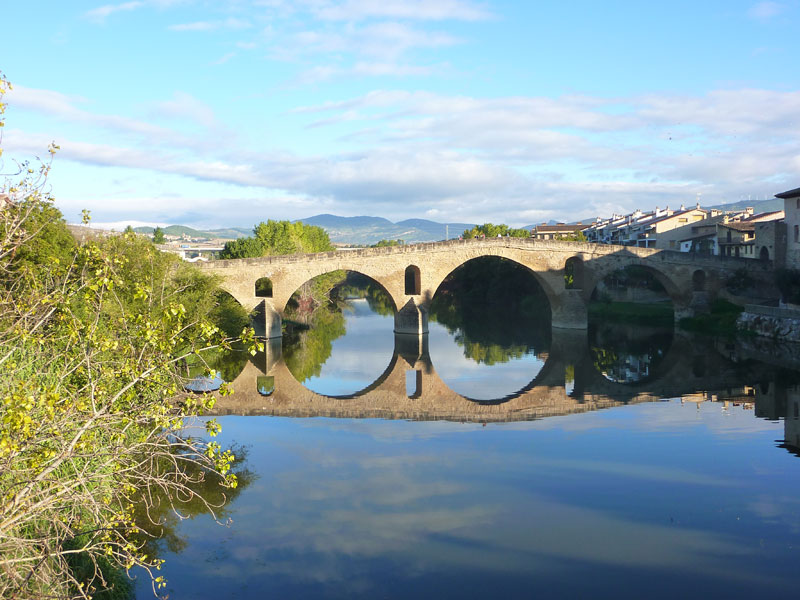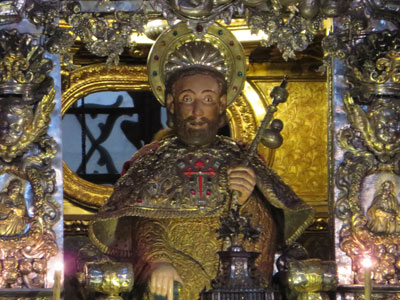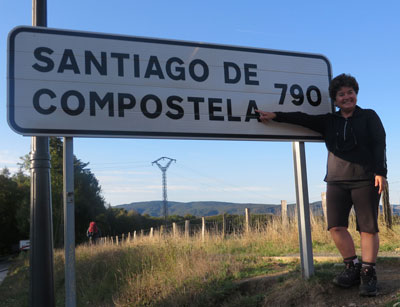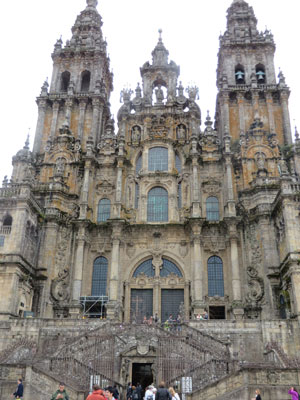Walking the Camino de Santiago – an individual experience
This article appears on page 34 of the March 2014 issue.
by Esther Perica; Arlington Heights, Il
I had long wanted to do the Camino de Santiago pilgrimage in northern Spain but waited too long to be physically able to do it the “right” way: with a backpack and walking the whole 500 miles. I looked at various companies when planning my September 2013 trip, but they all seemed to either target heavy-duty walkers or simply offer sightseeing tours with no walking at all.
Doing some research
In reading one of the online travel newsletters I visit (www.journeywoman.com), I came across a recommendation for Garry Budin, who lives in Santiago de Compostela and guides treks along the Camino. I emailed, explained my situation and asked about options.
Garry wrote back with the suggestion that a Canadian company called Teachers’ Travel/Walkers’ World (Toronto, Ont., Canada; 800/268-7229, 416/922-2232) might be just what I needed, and — guess what! — he guides for them, too.
The price of the 16-day tour was in the ballpark with those of other companies’ tours (CAD3,899, or $3,557, land only, with a single supplement of CAD800). I also paid $510 for three extra nights at Hotel Virxe de Cerca in Santiago de Compostela.
I checked the company’s website and the itinerary looked perfect. It included two guides and a support vehicle and covered a lot of the cultural aspects of the Camino, using expert local guides in the major cities of Burgos, León and Santiago de Compostela.
Walkers are divided into two groups, hearty walkers, called the “sportif group,” and leisurely walkers, the “tranquil group.”
Most meals were included, featuring some gargantuan picnic lunches with lots of great salads, cheeses and sausages along with gazpacho, a selection of fruit and wine. I signed up!
A trio of guides
The guides were excellent. Garry Budin is an Australian who has lived in Spain for 10 years and has done the Camino numerous times. His own company, Spanish Adventures, runs group and private tours in Spain and Portugal and also arranges luggage transfers and support vehicles for pilgrims walking the Camino on their own.
Deborah Wilson, a Brit with the soul of a Spaniard, was the assistant guide and was a great complement to Garry. She was charming, gracious, perceptive and kind and added oodles of finesse and much, much more to the published itinerary.
And, as luck would have it, Pablo, Deborah’s husband, went along, too. This was a huge plus, as he functioned as an additional guide and, since he often sat at the back of the bus, we could talk with him and ask questions on a more individual basis.
So we had a great trinity of souls guiding us. There was no way I was not going to have a good, productive and enriching time on this trip!
The walk
Our group met in Bilbao and immediately traveled by bus three hours to Roncesvalles and our first hotel.
The next morning our bus took us to Saint-Jean-Pied-de-Port, just over the Pyrénées in France. This is the official start of the popular French Way of the Camino de Santiago.
We had some free time there, so most of our group of 21 found our way to the Pilgrim Office to pick up our Pilgrim Credentials and get “stamped in.” Names go into a register, and walkers are listed as official “pilgrims.”
The Pilgrim Credential entitles you to stay at the albergues, or dormitories, along the route (we stayed in hotels and paradores) and provides various discounts, including on the admission prices of some museums.
This credential is what you show 500 miles later at the Cathedral Office in Santiago de Compostela to prove you completed the walk and are eligible to receive your Compostela, a certificate of completion (with the added plus of lessening your time in purgatory).
We all enjoyed getting our stamps (called sellos in Spanish) from various places: accommodations, restaurants, coffee bars, churches and museums, plus one from a man who sets himself up at the entrance to a teeny village and gives out candy along with a cheery “Buen Camino,” the traditional greeting for pilgrims. It was a fine record of our travels through Spain’s northern provinces of Navarre, Castilla y León, La Rioja and Galicia.
The trip was perfect. No matter what the tour member’s walking ability, accommodations were made. As predicted, I came to know the “sweep” guides (Deborah and/or Pablo) and the support vehicle driver pretty well, but I didn’t mind one bit!
The trek begins
Our first hike took about six hours. Essentially, it was a long, energetic and sometimes picturesque walk over the Pyrénées from France into Spain.
Distinct groups formed in less than an hour. There were about six strong walkers, a whole bunch in the middle group… then me.
It wasn’t that I couldn’t keep up. It was that I didn’t especially enjoy walking for walking’s sake. I wanted to see something other than my boots!
Where were the cute villages to wander around in? The scenic coffee stops? What about museums to explore?
So, with Deborah’s advice and, often, Pablo’s counsel, I concentrated on the easier and more interesting walks. Other times, the support bus took me to the group meeting point, usually a village. We called it “urban trekking,” and it gave me the opportunity to explore the town or village on my own.
“The Pilgrimage Road to Santiago,” a book which I thought would just be an interesting read during the trip, became essential. I read my copy at night, then used Garry’s book on the bus. This gave me insight into the history of what I was going to see and some words on the architecture. So on the days with difficult or long walking, I had my own urban adventures, along with a few serendipitous golden moments.
I soon created certain goals. I sought out churches and museums (some really obscure) and found myself on a quest to locate and photograph the old crosses that were put in place in the 15th to 19th centuries to mark the Camino route.
My favorite activity turned out to be talking to people. The beauty of the Camino is in the people you meet. I’ll always remember the three old women in León who, after giving me explicit directions to the Benedictine monastery (to pick up a Pilgrim Credential for someone who hadn’t purchased one at the trip’s start), spent time asking me about the US and why I was doing the Camino; the old man in Burgos who walked and talked with me along the river walk; a fellow traveler who took me through a nondescript entrance into a magnificent cloister and hidden chapel; the docents at the various museums and churches who answered my many questions, and many, many more people whom I encountered.
If I had done all the walking scheduled on the itinerary, it would have been about 200 kilometers (125 miles). I’d guess, including my village walkabouts, I did well over half of that.
I do want to mention that our hotels were great. Some were magnificent 4-star paradores (historic buildings turned into hotels), and others were small, family-run places that were atmospheric and sometimes very cozy. All were in the very best central locations. None of the hotels was a disappointment.
Along the Camino
If you’re on the Camino, you’ll visit a lot of churches. There seems to be one about every 100 feet. That is what the ancient pilgrims did, and we continued the tradition. Their Camino directionals were the ancient crosses, fountains and these 10th- through 19th-century churches.
Some are a step up from chapels — small, simple, rural affairs with plain altars and dusty wooden statues — and others are huge, elaborate and laden with gold.
When you finally reach Santiago de Compostela, you’ll find its magnificent cathedral, where the bones of St. James reside. I started to feel different when I entered this town, and, for some strange reason, I felt like I’d been there before.
This old, walled city was stunning. It must have been the icing on the cake of religious experiences for those ancient pilgrims. They would have been on the road for so long, staying in dirty, cramped quarters or even sleeping rough for months. To arrive at this gleaming city with its massive churches, monasteries and convents must have been overwhelming.
As for museums, I especially enjoyed this cathedral’s collection. Yes, I had seen many museums over the previous few weeks, but I didn’t want to miss this one. I even rented the audio guide (and was given the pilgrim’s discount).
My ticket allowed entry into parts of the immense cathedral not open to the general public as well as a close look at the Portico of Glory, the elaborately carved former entrance. I went down into the crypt and up in the rafters and explored the inner cloister, the treasure room, relics room and tapestries rooms.
I also spent time in the Bishop’s Palace, which was really a large room off the main church filled with displays. The best was a digital copy of the Codex Calixtinus. This 12th-century incunabulum traces the pilgrimage route from southern France to Santiago de Compostela and is considered the first travel guidebook ever written.
I was totally fascinated while turning the pages of this digital copy and must have spent 20 minutes on this exhibit alone. It took me three hours to get through the museum, and every moment was a jewel.
I ended up spending four days in this lovely city, one with the group and three on my own exploring the medieval streets, visiting any museum I could find and even doing a little shopping.
The end of the world
On the first day of my post-tour extension, I joined others who had also stayed on and we continued the trail (by bus) to Cape Finisterre, which in medieval times was considered to be the end of the world (finis = end, terrae = earth).
Since it was a Sunday, we went to the 10 o’clock Pilgrims’ Mass at the cathedral before departing, staying after the Mass to see them swung the Botafumeiro, a huge silver incense burner that is swung through the entire transept. At one point I thought it was coming straight at me, and I ducked!
The Botafumeiro is used only about 25 times per year, so we were fortunate to be present that day. Then we were picked up at 1:00 for the trip to Finisterre.
This outcrop on the ocean is the real end of the Camino. It is another three days’ walk, or two hours by bus, from Santiago de Compostela. At the farthest point out, pilgrims burn their clothes and throw their boots in the water!
Garry organized our transportation, and 15 of us went (at a really good price of €20, or $27, per person).
Our driver was excellent. She took us to various viewpoints, dropped us off at Tira do Cordel, a fish-and-seafood restaurant where Garry had made a reservation, and showed us a lot more than we bargained for.
You don’t have to be looking for anything or want to find anything when you do this walk. It can be just a beautiful hike in northern Spain. But there’s something special about being there. There is a spirit to it.
It’s a thousand-year-old trail. Saints have walked it. Kings and queens walked it. Pope Francis walked a portion of it. And, today, thousands of people, young and old, are walking it. All arrive with their own motivations of what their individual Camino experiences should be. No matter how much or how little of the Camino you walk, it is just right.
Some suggestions
This is what I would recommend to anyone wishing to learn a little more about the Camino de Santiago.
Watch “The Way,” a movie with Martin Sheen and Emilio Estevez. You’ll need to watch it twice, first for the story and second for the scenery and background.
Watch Rick Steves’ half-hour program on the Camino, which you can find online at Hulu. Feel free to skip the eight or so minutes on the running of the bulls in Pamplona at the beginning.
Buy the book “The Pilgrimage Road to Santiago: The Complete Cultural Handbook” by David M. Gitlitz and Linda Kay Davidson (ISBN 0312254164). If you want to explore villages or at least know what you are looking at, this book is a must. It covers the history, folklore, art and architecture of the Camino. It has not been updated since July 2000, but what you will be seeing has not been updated since the 10th century anyway.
Essentials for the walk
Sew a patch onto your backpack that identifies you as an American. This will make it much easier to connect with other English-speaking pilgrims.
On the first day, buy a pilgrims’ shell (a scallop shell, the symbol of the Camino) and attach it to your backpack. Available from the Camino office in Saint-Jean-Pied-de-Port and just about every store you pass during your entire trip, these shells identify walkers as pilgrims.
You must break in your boots and take the right socks. Wool is good, and make sure they are wicking. Shoelace locks are helpful so you don’t have to stop to retie your boots.
Even if you are used to a single walking pole, take along two, as this might help you balance better and will make it easier on your back as you walk.
Take either stretch gloves or workout gloves (fingerless, with leather palms), as they will not only keep your hands warm but will prevent blisters that might develop from using the walking poles.
A good-fitting day pack is essential. Consider a hydro-pack, as it’s important to drink lots of water while you walk.
Pants with pockets that close with zippers or Velcro-type fasteners not only keep pickpockets out, they keep your belongings from falling out on those “slight inclines.”
You need just two sets of walking clothes, but think “wicking.” You’ll also need a plastic rain poncho that will cover your backpack.
Finally, take a stone from home to lay at the Iron Cross (along with all your stresses and troubles).
Essentials for your comfort
It is not customary in Spain for hotels to have in-room coffee/tea facilities, so take your own travel pot or water immerser if you like your early-morning coffee.
Most places have WiFi, so a smartphone or tablet can be useful. Be sure to turn off the roaming feature on your cell phone. Roaming is super costly in Europe.
Take a bar of your favorite deodorant soap. Soaps in many hotels are minuscule and you get just one.
Take clothes that will dry overnight plus sandals or comfortable shoes and dressy pants and some tops for the evenings.
Take vaseline or BodyGlide® for your feet. This will do a lot to prevent rubbing and subsequent blisters.
A folding duffle that you can leave on the support bus is good to hold your “extra” stuff — things you bought, extra papers, etc. There is no reason to schlepp everything on/off the bus each night. There is room above the seats as well as space under your seat for any extra packages.
Be aware
Almost everything along the Camino is closed on Sundays. If you need snacks or other supplies, do your shopping on Saturday.
Footwear will take up most of the space in your luggage. I took ankle boots, walking shoes, sport shoes and sandals, and I wore them all.
Carry plenty of small change. This is useful at the coffee stops if you want to use the bathrooms. If you buy something, feel free to use the facilities at no extra charge, but if you don’t buy a coffee, cola, etc., then leave a few coins at the bar when you leave. (There are no public bathrooms along the Camino.)
Shopping
What you see most along the Camino are souvenirs and T-shirts. Prices seem to be higher at the beginning of the trip. (T’s run €10 to €15 between Saint-Jean-Pied-de-Port and Burgos, but, from León to Santiago, prices go down to €7 to €9. The designs seem to be universal.
As for silver jewelry with the shell motif, there was a good selection at O Cebreiro, a lovely village with cobblestone streets and two great gift shops. As you exit the church, go first to the shop on the left for the better selection of unique silver items. I bought a bracelet marked “925” and signed by the artist. I didn’t see the design anyplace else.
Also, stop in to visit the gift shop at the monastery at Samos. There is an excellent selection of silver at very good prices at the large gift shop. I don’t think the monks realized that silver had gone up almost 300% in the previous few years!
You will see many of the same designs in Santiago de Compostela, but prices will be higher. Be sure what you buy is marked “925” (for sterling).
If you can wait and hold onto your euros, Santiago de Compostela is shopping central. Every other building along the long, medieval streets is a shop offering every kind of souvenir you could want. I even saw St. James figurines by Lladro and jewelry and T-shirt designs not seen anywhere else. And it is the epicenter of everything silver.
Summing up
Somewhere along the trail, I noticed a woman with a great T-shirt that read “I was so far behind I thought I was first.”
That was me, and I loved being last. There was no one on my tail hurrying me along, and the only footsteps I heard were my own. The whole, wide trail was mine, and I could get lost in my thoughts and not worry about bumping into anyone. And I knew Deborah or Pablo was keeping an eye out to be sure that I stayed on the right path.
I liked knowing that St. Francis of Assisi had walked the same trails, as have millions of pilgrims since.





